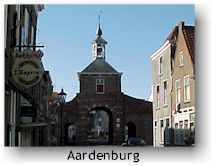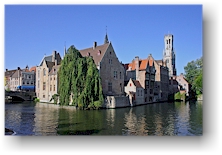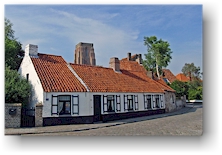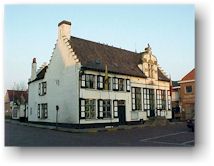|
PIcture: the Market square in Bruges |
|
|
In the area around Damme... With Damme as base, you can make beautiful trips to the surrounding villages and towns, each of them having their own character and things worth seeing. Something for everyone: enjoying the sun on the beach of Knokke, shopping in Sluis, museums in Bruges, taking the steamtrain in Maldegem,... There is more to these places than what is said in the stereotypes. And don't forget the little villages in Damme's neighboughood; many of them still maintained a lot of their original rural character. From the center of Damme, it will only take you a few minutes to get there. Below a list in alphabetical order. |
|
 Aardenburg. Aardenburg
is one of the oldest towns in Flanders (or should we say the Netherlands?).
Aardenburg lays, just like Sluis, in the Netherlands (Zeeuws-Vlaanderen)
but at a stone's throw from the border with Belgium. The
first settlement appears to have been here as early as 5500 BC (Stone
Age). Remnants from that period, the Roman era and the
Middle Ages can be seen in the town's archeological museum.
Worth seeing: the historic centre with the town hall, the market
square, the kiosk, two churches, the old Westgate, several
historical houses, the museum and foundations of the Roman
Castellum. [have a look] Aardenburg. Aardenburg
is one of the oldest towns in Flanders (or should we say the Netherlands?).
Aardenburg lays, just like Sluis, in the Netherlands (Zeeuws-Vlaanderen)
but at a stone's throw from the border with Belgium. The
first settlement appears to have been here as early as 5500 BC (Stone
Age). Remnants from that period, the Roman era and the
Middle Ages can be seen in the town's archeological museum.
Worth seeing: the historic centre with the town hall, the market
square, the kiosk, two churches, the old Westgate, several
historical houses, the museum and foundations of the Roman
Castellum. [have a look] |
||
 Abbey Ter Doest.
This abbey was founded as a branch of the abbey of "Ter Duynen"
(Koksijde). The abbey posessed an extended number of acres
of ground, was very rich and had several famous abbots.
From the convent itself, not much is left anymore, except for
the monumental barn and some more recent buildings. This
barn is one of the largest remaining gothic barns in Flanders.
Even to modern standards, it is huge. To get a real
impression of this enormous structure you should see this with
your own eyes. [have
a look]. Abbey Ter Doest.
This abbey was founded as a branch of the abbey of "Ter Duynen"
(Koksijde). The abbey posessed an extended number of acres
of ground, was very rich and had several famous abbots.
From the convent itself, not much is left anymore, except for
the monumental barn and some more recent buildings. This
barn is one of the largest remaining gothic barns in Flanders.
Even to modern standards, it is huge. To get a real
impression of this enormous structure you should see this with
your own eyes. [have
a look].
|
||
 Adegem.
Adegem is part of
Maldegem. The village is situated at some km from
Damme's territory, but is worth mentioning, especially
because of its old church. The settlement Adegem already exists
longtime; it already was mentioned in the days of St.-Amandus
(+/- 638 - 678). Worth
seeing: the war museum, the Canadian War Cemetery, the gardens
complex and the Saint-Adrian's Church. [have a look] Adegem.
Adegem is part of
Maldegem. The village is situated at some km from
Damme's territory, but is worth mentioning, especially
because of its old church. The settlement Adegem already exists
longtime; it already was mentioned in the days of St.-Amandus
(+/- 638 - 678). Worth
seeing: the war museum, the Canadian War Cemetery, the gardens
complex and the Saint-Adrian's Church. [have a look]
|
||
 Brugge/Bruges.
Good wine doesn't need a crown. There is no place in Belgim
where so many remains of Middle Ages can be found as in Bruges.
The history of
Damme has always been closely related to the history of
Bruges. Together they knew their times of glory, which made
them infamous all over the known world. But they also went down
together when the Zwin silted up and seaships could no longer
reach Bruges or one of her ports.
On cultural level, Bruges is the touristic hotspot in Belgium
and not without good reason! The complete, largely still
medieval centre of the town is listed as Unesco cultural
heritage. You can easily spend a few days in the charming,
burgundic town of Bruges. [more
info] Brugge/Bruges.
Good wine doesn't need a crown. There is no place in Belgim
where so many remains of Middle Ages can be found as in Bruges.
The history of
Damme has always been closely related to the history of
Bruges. Together they knew their times of glory, which made
them infamous all over the known world. But they also went down
together when the Zwin silted up and seaships could no longer
reach Bruges or one of her ports.
On cultural level, Bruges is the touristic hotspot in Belgium
and not without good reason! The complete, largely still
medieval centre of the town is listed as Unesco cultural
heritage. You can easily spend a few days in the charming,
burgundic town of Bruges. [more
info] |
||
 Donk.
Is a small, rural village, part of Maldegem. You
immediately spot the nice little church next to the cobblestone
street. A must is the rural museum "Smoefelbeekhoeve",
where you can see old agricultural material, but next to that an
impressive collection of oldtimer tractors and a rebuilt forge.
[have a look] Donk.
Is a small, rural village, part of Maldegem. You
immediately spot the nice little church next to the cobblestone
street. A must is the rural museum "Smoefelbeekhoeve",
where you can see old agricultural material, but next to that an
impressive collection of oldtimer tractors and a rebuilt forge.
[have a look] |
||
| Dudzele. The remarkable thing about Dudzele is not that the village has a church but that it has two churchtowers. You don't need to be an archeologist to see that the solitary tower is the oldest one; it's in romanesque style and dates back to the 12th century. Worth seeing: the romanesque tower, some 17th century houses and old farms. [have a look] | ||
| Fortress of Bavaria. This fortress was built as a result of the Spanish Succession war (1701 - 1714). It served as a protection for Bruges against possible attacks from the north. However, it was never attacked and honestly wasn't used for long. Once it lost it's military interest, the fortress was sold and converted into a castle park. The bastions, earthen walls and ditches in pentagonal shape are still visible and have become home to a specific fauna and flora. [more info] | ||
 Knokke-Heist.
Mondain Knokke is often referred to as the Monaco of the Belgian
coast and not without good reason. Here you can find
anything money can buy from expensive shops to exclusive villas.
Heist is a lot more modest but not less attractive. The
absolute highlight is the wide, fine sandy beach but there are
certainly also other things worth seeing and doing such as the
nature reserve "Zwin" and the Sincfala museum to name just a
few. Versatility of this coastal town is probably its best
asset. [more info] Knokke-Heist.
Mondain Knokke is often referred to as the Monaco of the Belgian
coast and not without good reason. Here you can find
anything money can buy from expensive shops to exclusive villas.
Heist is a lot more modest but not less attractive. The
absolute highlight is the wide, fine sandy beach but there are
certainly also other things worth seeing and doing such as the
nature reserve "Zwin" and the Sincfala museum to name just a
few. Versatility of this coastal town is probably its best
asset. [more info] |
||
 Koolkerke.
The name "Coolkercke" was recorded for the first time
in 1243, but the village did exist already a while before.
On the highest place, the first church was built around 1150.
The present church is a protected monument and dates from 1860,
with parts from the 14th century. Worth seeing are the
church, the presbytery, a number of old farms, the
fortress of Bavaria
and Castle "Ten Berghe". [have
a look] Koolkerke.
The name "Coolkercke" was recorded for the first time
in 1243, but the village did exist already a while before.
On the highest place, the first church was built around 1150.
The present church is a protected monument and dates from 1860,
with parts from the 14th century. Worth seeing are the
church, the presbytery, a number of old farms, the
fortress of Bavaria
and Castle "Ten Berghe". [have
a look] |
||
 Lissewege.
Between Bruges and
Zeebruges, not far from
Dudzele lays a charming, tranquil village named Lissewege.
Nowadays it is known as an artists village and is also nicknamed
the white village, referring to the white-painted houses.
Worth seeing ar the old centre, the Our Ladies Church,
the abbey of Ter
Doest, the barn of the abbey, the presbytery. [have
a look] Lissewege.
Between Bruges and
Zeebruges, not far from
Dudzele lays a charming, tranquil village named Lissewege.
Nowadays it is known as an artists village and is also nicknamed
the white village, referring to the white-painted houses.
Worth seeing ar the old centre, the Our Ladies Church,
the abbey of Ter
Doest, the barn of the abbey, the presbytery. [have
a look]
|
||
 Maldegem.
Maldegem is one of the largest communities in East-Flanders (in
terms of surface). Untill the 13th century, the area was
mainly covered with woods and swamps. From medio 14th
century, annual markets (fairs) were held, a privilege given by
count Louis from Male (see Male).
In fact, there still is a weekly market. Worth seeing are
the churh, the stately town hall and certainly the Steam Center.
[have a look] Maldegem.
Maldegem is one of the largest communities in East-Flanders (in
terms of surface). Untill the 13th century, the area was
mainly covered with woods and swamps. From medio 14th
century, annual markets (fairs) were held, a privilege given by
count Louis from Male (see Male).
In fact, there still is a weekly market. Worth seeing are
the churh, the stately town hall and certainly the Steam Center.
[have a look] |
||
 Male.
At a stone's throw from Sijsele
lays the village of Male. Male used to be a part of
Sijsele (one of the oldest settlements in the region), but is
now a part of Bruges.
Male has a small but very beautiful old centre with some old,
charming farmhouses. The most important building in the
village however is the monumental castle. As soon as the
9th century the first defensive tower was built here to protect
the land against attacks from vikings. Worth seeing:
castle (now abbey), centre of the village with several old
farmhouses. [have a look] Male.
At a stone's throw from Sijsele
lays the village of Male. Male used to be a part of
Sijsele (one of the oldest settlements in the region), but is
now a part of Bruges.
Male has a small but very beautiful old centre with some old,
charming farmhouses. The most important building in the
village however is the monumental castle. As soon as the
9th century the first defensive tower was built here to protect
the land against attacks from vikings. Worth seeing:
castle (now abbey), centre of the village with several old
farmhouses. [have a look] |
||
 Middelburg.
Barely a few kilometers from Den
Hoorn, just on the other side of the provincial border with
East-Flanders, lays Middelburg. This community is a part
of Maldegem. It was
built between 1452 and 1465 on the order of Pieter Bladelin,
governor of finance of no other than Phillips the Good and
treasurer of the Order of the Golden Fleece. Worth seeing:
church, pelerin and museum. Unfortunately, the foundations
of the castle of
Middelburg cannot be seen anymore. The Bladelinmuseum
makes up for that though. [have
a look] Middelburg.
Barely a few kilometers from Den
Hoorn, just on the other side of the provincial border with
East-Flanders, lays Middelburg. This community is a part
of Maldegem. It was
built between 1452 and 1465 on the order of Pieter Bladelin,
governor of finance of no other than Phillips the Good and
treasurer of the Order of the Golden Fleece. Worth seeing:
church, pelerin and museum. Unfortunately, the foundations
of the castle of
Middelburg cannot be seen anymore. The Bladelinmuseum
makes up for that though. [have
a look] |
||
 Oedelem.
South of Sijsele lays the
village of Oedelem. This community is part of Beernem.
The area of Oedelem has been inhabited for about 10.000 years,
situated back then mainly in the hilly side of the region.
Just like in Aardenburg,
there also was Roman presence in Oedelem. Worth seeing is
the market square with the nice communal house and the church. [have
a look] Oedelem.
South of Sijsele lays the
village of Oedelem. This community is part of Beernem.
The area of Oedelem has been inhabited for about 10.000 years,
situated back then mainly in the hilly side of the region.
Just like in Aardenburg,
there also was Roman presence in Oedelem. Worth seeing is
the market square with the nice communal house and the church. [have
a look] |
||
 Sint-Anna-ter-Muiden.
Situated practically on the border between the Netherlands and
Belgium is the very picturesque village of Sint-Anna-ter-Muiden.
"Mude", as it was called back then, was founded around 1200, so
before the bigger neighbouring town of
Sluis. During a while
it was an important port; the monumental tower of the church is
a silent reminder of that. Worth seeing are the church
with its tower, the village pump, the market square and the
surrounding houses and farmhouses. [have
a look] Sint-Anna-ter-Muiden.
Situated practically on the border between the Netherlands and
Belgium is the very picturesque village of Sint-Anna-ter-Muiden.
"Mude", as it was called back then, was founded around 1200, so
before the bigger neighbouring town of
Sluis. During a while
it was an important port; the monumental tower of the church is
a silent reminder of that. Worth seeing are the church
with its tower, the village pump, the market square and the
surrounding houses and farmhouses. [have
a look] |
||
 Sluis.
If you follow the "Damse
Vaart" from Damme in
northern direction, you eventually end up in Sluis. Sluis
is located in Zeeuws-Vlaanderen (Netherlands) and was a very
important harbour. Nowadays it's a pleasant shoppingtown
with cosy terraces. Worth seeing are the town walls, the
town gates, the quay, the belfort (the only one in the
Netherlands!), the windmill and the town centre. [have
a look] Sluis.
If you follow the "Damse
Vaart" from Damme in
northern direction, you eventually end up in Sluis. Sluis
is located in Zeeuws-Vlaanderen (Netherlands) and was a very
important harbour. Nowadays it's a pleasant shoppingtown
with cosy terraces. Worth seeing are the town walls, the
town gates, the quay, the belfort (the only one in the
Netherlands!), the windmill and the town centre. [have
a look] |
|
© Hendrik De Leyn - www.damme-online.com |

